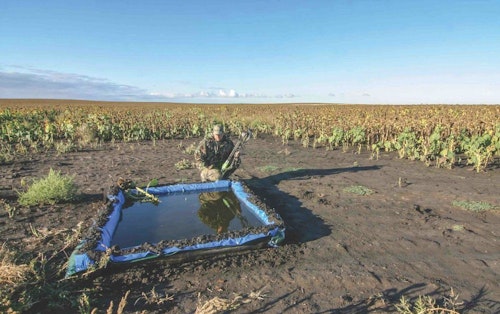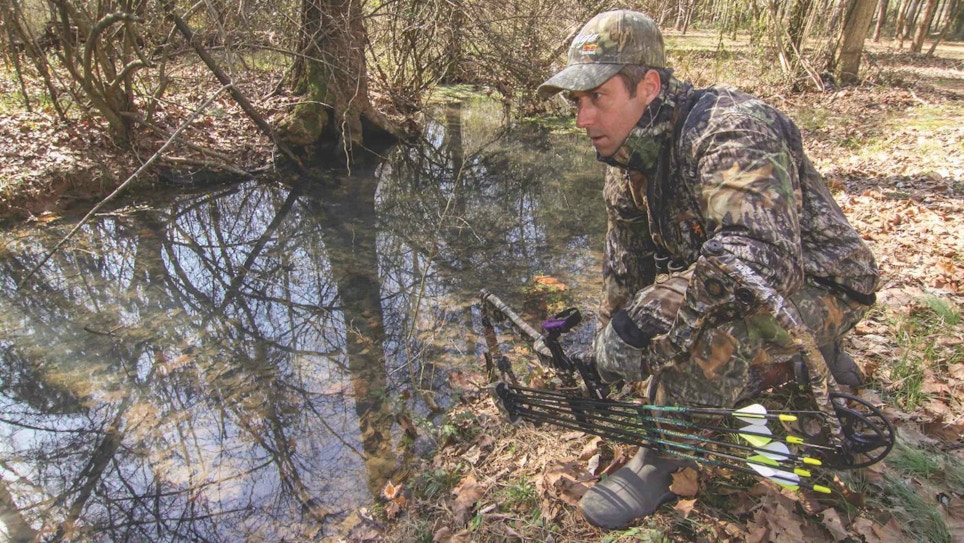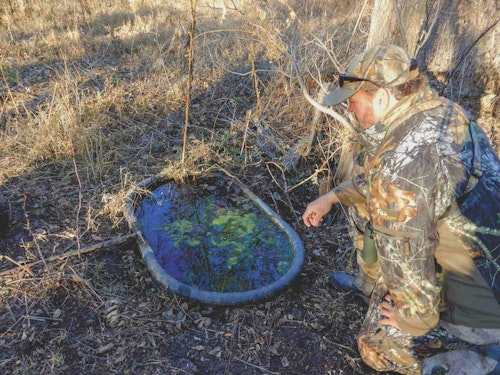You can survive without food for a month or more, but without water for 2 or 3 days, it’s an Arnold Schwarzenegger, “Hasta la vista, Baby” ending. Hardier whitetails can likely outlast you in either department, but they still need both.
For obvious reasons, whitetail managers focus on food and food plot preparation. In their haste, they may overlook the obvious element of adding water to a property. It’s easy to overlook, but if you don’t have consistent water sources for your whitetails, when thirst hits, deer could leave in search of the precious commodity, getting into trouble during their search. Don’t be a troublemaker; make sure your whitetails can order up a drink anytime.
Regular Drink, Please
Deer acquire their water through different means. Weight and weather are the two leading factors that determine how much water a whitetail requires daily. Most research states that for every 100 pounds of weight, a deer requires approximately 2 quarts of water per day. For a mature deer, that equals a minimum of 4 quarts per day in typical conditions with slightly less required in winter. When temperatures spike, expect deer to visit water with more regularity. Deer also need more water during gestation, while nursing fawns and during adolescent growth spurts. Even antler growth requires an increase in water that correlates with summer heat surges.
Like you holding a Big Gulp soft drink, deer slurp it down when water is readily available. Creeks, rivers, ponds, lakes, springs and even livestock tanks serve as hydration sources for many deer. Deer also acquire a large percentage of their daily intake from vegetation. This is referred to as preformed water by biologists. Depending on the time of year, deer can acquire most of their needs simply by eating, especially during the lush period of early summer.
After a long morning of browsing on dewy crops such as alfalfa, whitetails may not even look at a pond on their way to bedding cover. A final method for deer to acquire hydration is through metabolic water — the process of oxidizing carbs, proteins and fats, which release water. As much as you cherish that Big Gulp at the big ball game, deer may only grab a drink to supplement what they cannot extract from eating.
If the property you hunt has more water than New Orleans after Hurricane Katrina, then you can grab a Big Gulp and relax. For the rest of you, an inventory is in order. In a perfect world, the home range of your whitetails should have one or more consistent sources of year-round water. Home ranges vary across whitetail country, but for argument’s sake let’s follow the 1-square-mile rule. Ideally, you’d have a minimum of one good source in that home range that deer can count on for quenching. Don’t get too comfortable. The location of bedding cover, food plots, property lines and the size of your hunting property also play a pivotal role in the water equation. All of this could begin to boggle your mind, but there is one easy way to assess your water situation.
From your scouting, you likely have a good idea of where deer are bedding, feeding and traveling. To ensure deer stay on your property utilizing your habitat, look for water that allows pit stops along these routes. Deer tend to crave a drink after bedding all day, especially in hot temperatures. They also grab a drink on their way back, after an evening of feeding. Water situated in or near bedding cover allows deer to hydrate without exposing themselves. Water near food plots gives deer an easy option for an after dinner drink. Placing trail cameras at these locations can verify your assumptions, with the caveat that when vegetation is lush, the water source may be by-passed.
If you don’t have water sources in these areas then trouble begins to brew as deer could seek it elsewhere. During a hot, autumn afternoon, it could lead to deer crossing your fence into the shooting lane of a neighboring hunter.

Ponds-a-Plenty
On water-challenged properties, you do have options and most don’t require a well-drilling contractor. You can add water to a property inexpensively, and summer is an ideal time for any projects. Before you begin excavating, look for the best places to situate water. You’ve heard of hunting plots, what about hunting ponds?
Look for areas that provide possible ambush opportunities. You want to avoid placing water in the wide open. Deer will only use open water sources under the cover of darkness, and secondly, it offers little cover for your hide.
As you scout, you may discover seeps or hidden water you never knew existed. Deer don’t need a swimming pool to fill up; and small sources are oftentimes preferred, particularly those in heavy cover. If you have a history with a property, most of these will jump out at you.
Next, determine how to put water where you want it. A buried kiddie swimming pool or even a livestock tank can be used to catch water from a year-round seep, an artesian spring or even a nearby farm well. If water is inconsistent, you can fill the receptacles with a tank mounted on an ATV or UTV. Small gullies or washouts can be lined with durable rubber linings or better yet, bentonite. When it rains, they’ll fill and with a little luck, Mother Nature will replenish them regularly. A rented skid-steer loader can also dig a pond quickly that can be lined with the previous products for a natural fill up.
Any plan should include a visit to your local Natural Resources Conservation Service. These federal professionals can offer insight on ways to build water sources on a property, and better yet may even have funds to aid your enhancement efforts. It’s worth a visit over a morning cup of coffee.
Once you complete the hot tub project, plan on hunting it during the season. Although you may be tempted just to hunt it in the early, sizzling part of the season, make a date to watch it during the rut before freeze-up. Bucks thirsty from a 24/7 rutting schedule could stop by for an energizing drink at any time. Water is still a necessity, regardless of the temperature.
Whitetails have a better system than humans do to acquire water daily; but nonetheless, they need a 365-day source. Creating water sources aids the overall health of a herd; and may just put a target buck within shooting distance this fall. Best of all, he won’t see you draw your bow, as he’ll be busy with his Big Gulp.







